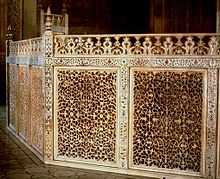Jali

A jali or jaali, (Gujarati: જાળી) is the term for a perforated stone or latticed screen, usually with an ornamental pattern constructed through the use of calligraphy and geometry. This form of architectural decoration is found in Indian architecture, Indo-Islamic Architecture and Islamic Architecture.
Early jali work was built by carving into stone, while later by the Mughals who employed the technique of inlay, using marble and semi-precious stones.[1]
Gallery
-

Intricate jaali screens surrounding the cenotaphs, Taj Mahal interior.
-

Details of Jaali screens of marble pierce work, surrounding royal cenotaphs, Taj Mahal, Agra.
-

One of the famous intricate jaalis from the Sidi Saiyyed mosque in Ahmedabad, India
-

Jali at Tomb of Salim Chishti, Fatehpur Sikri, India
Footnotes
- ↑ Thapar, B. (2004). Introduction to Indian architecture. Singapore: Periplus. pg. 81
External links
| Wikimedia Commons has media related to Jali. |
- ArchNet Dictionary of Islamic Architecture: Jali
- The Flame and the Lotus: Indian and Southeast Asian Art from the Kronos Collections, an exhibition catalog from The Metropolitan Museum of Art (fully available online as PDF), which contains material on Jali (no. 60)
- Ahmedabad-based architect, historian and author Yatin Pandya on jaali as a traditional element, an online article from DNAIndia